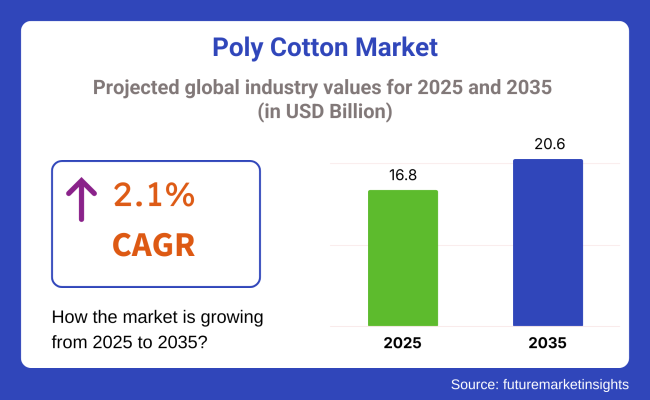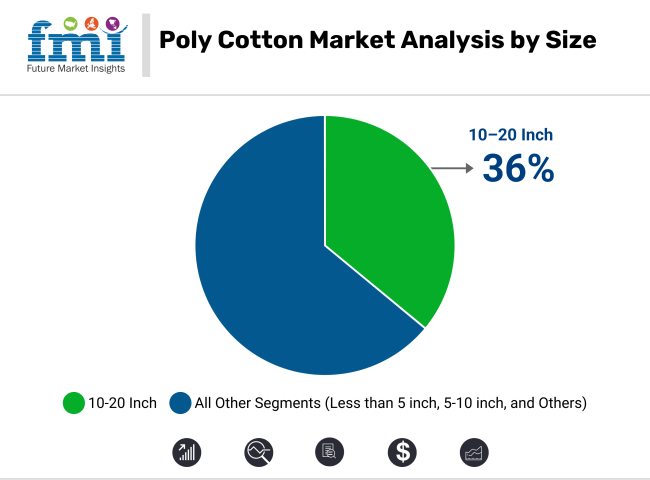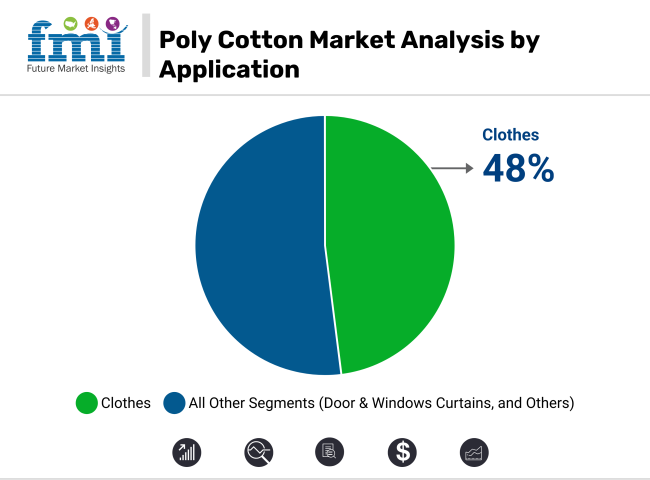The global sales of poly cotton are estimated to reach USD 16.8 billion in 2025 and are projected to grow to USD 20.6 billion by 2035. A compound annual growth rate (CAGR) of 2.1% has been forecast over the assessment period.
Demand is being supported by the widespread use of poly cotton in both consumer and industrial sectors. The blend’s properties- softness from cotton and strength and wrinkle resistance from polyester- have positioned it as a preferred fabric for uniforms, casual wear, and home furnishings.
Significant growth has been observed in the performance apparel and athleisure categories. Demand for breathable, moisture-wicking poly cotton blends is being driven by rising health and fitness trends. Technological advancements in textile finishing, including chemical treatments for stain and wrinkle resistance, have allowed manufacturers to address evolving consumer preferences.
Sustainability efforts are also influencing the market landscape. The Textile Exchange’s 2025 Recycled Polyester Challenge has encouraged global brands to commit to sourcing between 45% and 100% of their polyester content from recycled materials by 2025. This initiative has created pressure on poly cotton supply chains to incorporate recycled and traceable inputs.
Environmental compliance and supply chain transparency are being prioritized. Eco-labels and voluntary certifications are gaining momentum, especially in Europe and North America. In parallel, product development is focusing on closed-loop manufacturing and biodegradable alternatives to meet future sustainability benchmarks.

Alfonso Marra, CEO of Klopman International, highlighted the direction of the industry in an interview with Fibre2Fashion: “We expect that the market will evolve to higher quality products based on the demand of more fashionable workwear. Also, the sustainable aspects of fabrics used will become more and more important.”
As regulations tighten and consumer expectations shift, innovation in sustainable poly cotton blends is expected to become a major driver. The market outlook for poly cotton remains stable, shaped by durable product characteristics and advancing alignment with ethical sourcing frameworks.
In the poly cotton market, the 10-20 inch size segment holds the leading share, accounting for approximately 36% of global sales in 2025. This dominance stems from the segment’s suitability across a broad range of textile applications, particularly in standardized garment production. The segment is projected to expand at a Compound Annual Growth Rate (CAGR) of 1.8% between 2025 and 2035, reflecting steady demand across the fashion, uniform, and furnishing sectors.

This size range offers a balanced width that supports efficient material handling and compatibility with automated weaving and cutting machinery. Apparel manufacturers favor it for producing poly cotton-based t-shirts, trousers, school uniforms, and casualwear. Additionally, textile suppliers frequently supply fabrics in this range due to its lower wastage ratio during production and ease of packaging and transportation.
As sustainability and cost-efficiency continue to shape sourcing decisions, the 10-20 inch format remains an industry standard, particularly in high-volume markets across Asia and North America. The segment’s future growth will also benefit from growing investments in industrial-scale textile processing infrastructure and rising global apparel exports.
Clothes represent the largest application segment in the poly cotton market, contributing to around 48% of total market demand in 2025. This segment is expected to grow at a CAGR of 1.6% from 2025 to 2035, driven by the material’s inherent advantages such as comfort, breathability, and strength.
The widespread use of poly cotton in workwear, uniforms, school clothing, and casual garments ensures a sustained consumption rate. Its affordability and ability to combine cotton's softness with polyester's durability make it highly favored among clothing manufacturers. Furthermore, its wrinkle resistance and ease of maintenance continue to appeal to mass-market apparel brands globally.

The rising trend of blended fabrics in the athleisure and functional apparel segments further cements clothing as the core application area. Brands seeking lightweight, moisture-wicking, and versatile textiles increasingly prefer poly cotton, especially in regions such as North America, Europe, and Southeast Asia.
With evolving fashion cycles and growing consumer preference for easy-care fabrics, the clothing segment will remain the primary growth anchor for the poly cotton market in the long term.
Challenges
Sustainability Concerns and Price Volatility
The market of poly cotton market struggles with growing sustainability concerns are becoming more widespread as polyester is a petroleum-based fiber that contributes to micro plastic pollution and other forms of environmental degradation. Brands and consumers are looking for green alternatives, prompting manufacturers to experiment with recycled polyester and organic cotton mixes.
From another hand, business risks relating to price volatility are prevalent in the production of raw materials used in the textile industry, particularly cotton and polyester derived from crude oil which affects production cost as well as the market stability.
Opportunities
Growth in Performance Fabrics and Recycled Poly Cotton Blends
Poly cotton is still popular despite concerns about the environment because of its durability, wrinkle resistance, and affordability. Growth in sportswear, work wear and home textiles is driven by demand for moisture-wicking, anti-microbial and stain-resistant fabrics. You are also making advancements in recycled polyester (rPET) and sustainable dyeing technologies to provide eco-friendly poly cotton alternatives that are circular economy compliant.
The growing demand from the segments such as apparel, home textiles, and industrial applications has led to a steady growth in the United States Poly Cotton market. In addition, the increasing use of poly cotton blends in the apparel sector on account of their durability, breathability, and cost-effectiveness is driving the growth of the market.
Market trends are driven by the emergence of environmentally friendly textiles manufacturing and dyeing processes. The growth in the market is also benefitted by the rising demand for poly cotton from work wear and uniforms and the innovations in blended fabrics.
| Country | CAGR (2025 to 2035) |
|---|---|
| USA | 2.5% |
The UK poly cotton market is expected to grow at a steady pace during the forecast period, according to the latest report by the research firm. The wear ability of comfortable and wrinkle-resistant fabrics in casual and professional clothing is takes the charge in market demand.
Moreover, growing investments in textile recycling and sustainable poly cotton manufacturing is impacting the market growth. Growing preference for lightweight, easy to care fabrics in retail and commercial sectors is also creating demand, thereby enabling market growth.
| Country | CAGR (2025 to 2035) |
|---|---|
| UK | 2.0% |
The European Union (EU) poly cotton market has experienced moderately stable growth over the past few years, supporting by the increasing adoption rate of Poly Cotton in clothing, bedding and technical textiles. Furthermore, European Union directives focused on sustainable production in textiles and circular economy initiatives encourage innovations, for example, in recycled poly cotton fabrics.
Key markets include Germany, France and Italy, with denim, automotive and home textiles being among the strong demand drivers. The growing demand for wrinkle-free and easy-care fabrics is also driving growth of poly cotton blends.
| Region | CAGR (2025 to 2035) |
|---|---|
| EU | 2.9% |
The Japan poly cotton market is growing as the country has a robust textile industry and demand for blends across the consumers. Market growth is being driven by the demand for durable, soft, and lightweight fabrics for various applications, including fashion, bedding, and industrial uses.
Market trends are being shaped by the adoption of advanced textile processing technologies and sustainable fiber blends. Furthermore, demand is driven by Japan's emphasis on functional and moisture-wicking fabrics for sportswear and casual wear.
| Country | CAGR (2025 to 2035) |
|---|---|
| Japan | 2.2% |
Poly cotton market in South Korea is growing at a rapid pace due to the increasing demand in apparel and home textile, etc. Also, innovation in textile leads to the increased demand for comfortable and wrinkle-free textiles for work wear, school uniforms, and in everyday clothes, is anticipated to fuel the market demand.
Market growth is spurred by advances in sustainable textile manufacturing and polyester-cotton blending methods. Furthermore, the growth of K-fashion and the popularity of e-commerce has also been influencing the demand in the poly cotton market in South Korea.
| Country | CAGR (2025 to 2035) |
|---|---|
| South Korea | 2.1% |
TORAY Industries, Inc. (18-22%)
TORAY leads the poly cotton market with advanced fabric technologies, catering to high-performance apparel, home textiles, and industrial applications.
Reliance Industries Limited (14-18%)
Reliance is a key supplier of poly cotton blends, focusing on recycled fibers and eco-friendly textile innovations.
Sinopec Yizheng Chemical Fibre Company (12-16%)
Sinopec dominates in polyester fiber production, supplying poly cotton yarns and blended fabrics for global textile industries.
Luthai Textile Co., Ltd. (10-14%)
Luthai specializes in high-quality poly cotton fabrics for formal wear, business attire, and professional uniforms.
Milliken & Company (8-12%)
Milliken provides poly cotton textiles with enhanced durability, offering wrinkle-resistant, antimicrobial, and flame-retardant properties.
Other Key Players (26-32% Combined)
Several emerging and niche textile manufacturers are contributing to poly cotton innovation and sustainability, including:
The overall market size for poly cotton market was USD 16,802.8 million in 2025.
The poly cotton market is expected to reach USD 20,684.2 million in 2035.
Increasing demand for durable and cost-effective blended fabrics, rising adoption in apparel and home textiles, and growing preference for wrinkle-resistant and easy-care materials will drive market growth.
The top 5 countries which drives the development of poly cotton market are USA, European Union, Japan, South Korea and UK.
Bed sheets and pillow covers expected to grow to command significant share over the assessment period.






Our Research Products

The "Full Research Suite" delivers actionable market intel, deep dives on markets or technologies, so clients act faster, cut risk, and unlock growth.

The Leaderboard benchmarks and ranks top vendors, classifying them as Established Leaders, Leading Challengers, or Disruptors & Challengers.

Locates where complements amplify value and substitutes erode it, forecasting net impact by horizon

We deliver granular, decision-grade intel: market sizing, 5-year forecasts, pricing, adoption, usage, revenue, and operational KPIs—plus competitor tracking, regulation, and value chains—across 60 countries broadly.

Spot the shifts before they hit your P&L. We track inflection points, adoption curves, pricing moves, and ecosystem plays to show where demand is heading, why it is changing, and what to do next across high-growth markets and disruptive tech

Real-time reads of user behavior. We track shifting priorities, perceptions of today’s and next-gen services, and provider experience, then pace how fast tech moves from trial to adoption, blending buyer, consumer, and channel inputs with social signals (#WhySwitch, #UX).

Partner with our analyst team to build a custom report designed around your business priorities. From analysing market trends to assessing competitors or crafting bespoke datasets, we tailor insights to your needs.
Supplier Intelligence
Discovery & Profiling
Capacity & Footprint
Performance & Risk
Compliance & Governance
Commercial Readiness
Who Supplies Whom
Scorecards & Shortlists
Playbooks & Docs
Category Intelligence
Definition & Scope
Demand & Use Cases
Cost Drivers
Market Structure
Supply Chain Map
Trade & Policy
Operating Norms
Deliverables
Buyer Intelligence
Account Basics
Spend & Scope
Procurement Model
Vendor Requirements
Terms & Policies
Entry Strategy
Pain Points & Triggers
Outputs
Pricing Analysis
Benchmarks
Trends
Should-Cost
Indexation
Landed Cost
Commercial Terms
Deliverables
Brand Analysis
Positioning & Value Prop
Share & Presence
Customer Evidence
Go-to-Market
Digital & Reputation
Compliance & Trust
KPIs & Gaps
Outputs
Full Research Suite comprises of:
Market outlook & trends analysis
Interviews & case studies
Strategic recommendations
Vendor profiles & capabilities analysis
5-year forecasts
8 regions and 60+ country-level data splits
Market segment data splits
12 months of continuous data updates
DELIVERED AS:
PDF EXCEL ONLINE
Poly Cotton Fabric Market Growth - Trends & Forecast 2025 to 2035
Polyester Microfiber Fabric Market Size and Share Forecast Outlook 2025 to 2035
Polymer Mixing Unit Market Size and Share Forecast Outlook 2025 to 2035
Polyester Shrink Film Market Size and Share Forecast Outlook 2025 to 2035
Polymeric Brominated Flame Retardants Market Size and Share Forecast Outlook 2025 to 2035
Polyurethane Coating Market Size and Share Forecast Outlook 2025 to 2035
Polypropylene Woven Bag and Sack Market Size and Share Forecast Outlook 2025 to 2035
Polyaspartic Acid Salt Market Size and Share Forecast Outlook 2025 to 2035
Polyphenylene Market Forecast Outlook 2025 to 2035
Polyimide Film and Tape Market Forecast Outlook 2025 to 2035
Polymer-based Prefilled Syringe Market Size and Share Forecast Outlook 2025 to 2035
Polymer Modified Bitumen Market Forecast and Outlook 2025 to 2035
Polycarbonate Junction Box Market Forecast and Outlook 2025 to 2035
Polyvinyl Chloride (PVC) Packaging Film Market Forecast and Outlook 2025 to 2035
Polydimethylsiloxane Market Forecast and Outlook 2025 to 2035
Polypropylene Yarn Market Size and Share Forecast Outlook 2025 to 2035
Polysaccharide Films Market Size and Share Forecast Outlook 2025 to 2035
Polysilicon Market Size and Share Forecast Outlook 2025 to 2035
Polytetrahydrofuran (Poly THF) Market Size and Share Forecast Outlook 2025 to 2035
Polysulfide Market Size and Share Forecast Outlook 2025 to 2035

Thank you!
You will receive an email from our Business Development Manager. Please be sure to check your SPAM/JUNK folder too.
Chat With
MaRIA